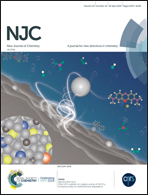Dependence of the photo-response behavior of self-assembled 2D Azo-derivatives on the functional groups on a solid surface†
Abstract
Azobenzene (Azo) is a kind of important photo-chromic building block for constructing photo-responsive materials. It is well known that the cis–trans isomerization of Azo derivatives can easily occur under suitable light irradiation. However, there are few studies on controlling such isomerization through tuning the intermolecular non-covalent interactions. Here, by means of scanning tunneling microscopy (STM), we found that the two-dimensional (2D) self-assembled monolayers of four Azo derivatives exhibited different isomerization behaviors when taken from dark to irradiation conditions. Based on the proposed molecular models, we found that the substituent position of the carboxyl groups controlled the photosensitivity of the Azo unit. Two kinds of interactions, van der Waals and hydrogen bonding interactions, originating from the long alkoxyl chains and carboxyl groups, were introduced to investigate the photo-response of the central Azo units in these four Azo-based derivatives. This study indicates that the photo-response property of Azo-based materials strongly depends on the intermolecular interactions, which are closely related to the modification of the chemical structure. The switchable behavior of the 2D supramolecular network might be useful for fabricating optical switching devices.



 Please wait while we load your content...
Please wait while we load your content...